9th page - Links and References
We can link external documents and records from other K2 modules to records on the 9th page. The Attached Processes section displays the workflow processes which relate to the record.
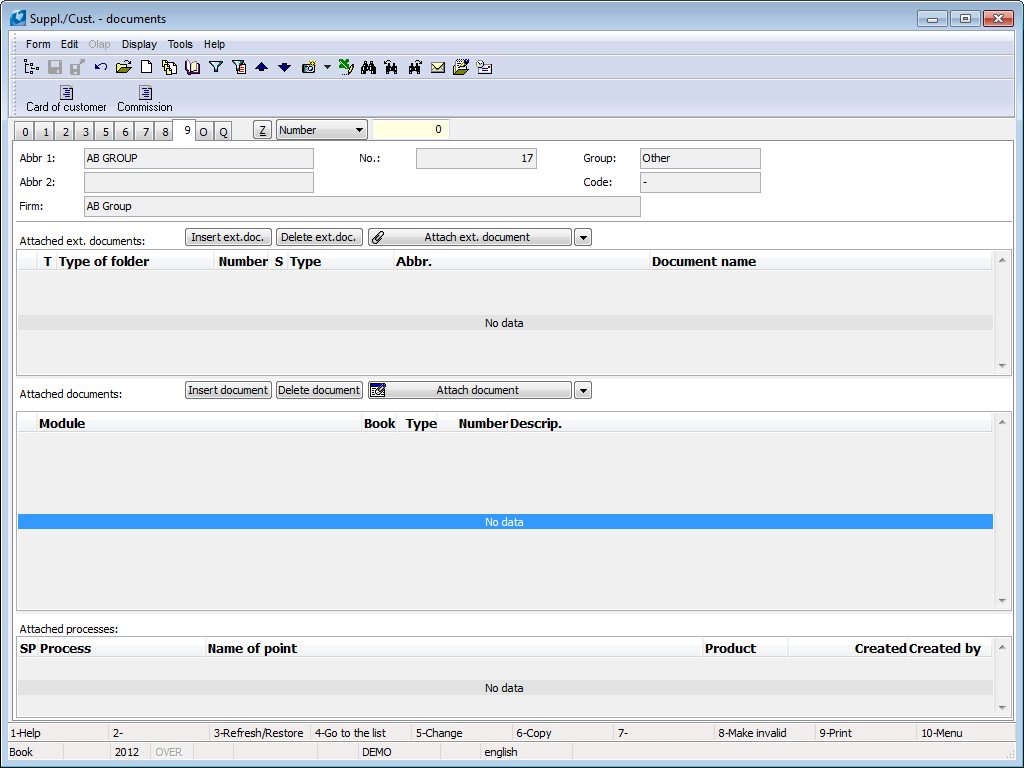
Picture: Suppl./Cust. - 9th page
With the use of the Attach Document button on the 9th page, it is possible to choose documents to link even with the link type. After you first press the button, a menu with link types of documents will appear. The selected type will be remembered and when you press the button next time, a book with the the selected type of documents will open. To select the document link type you can also use the arrow located next to the button.
The Document Link Type code list can also be displayed in the Client parameters - 4th page - button Document Types. For each type of document linking, we can select a list of documents which are enabled for this link - the button Document Types to Link Types .
The code list contains the following links:
- Tax invoice,
- Actual invoice to the tax invoice,
- Original invoice to credit note,
- Original invoice to discount,
- General,
- Credit note,
- Discount.

Picture: Open menu with the document types
On the 9th page of a document the button Attach Ext. Document is added, which contains list of doc. types. You can insert more document together. According to the inserting document either a type is automatically selected, or menu with selection of types displays. Using of the button is analogous as at the button Attach document.
The code list contains these types of documents:
- ALL: Use original,
- DS_DOC: DEMO/DSDOC, Unique transfer,
- OFI: Demo/Demands, Unique copy,
- OFO: DEMO/Offers, Unique copy,
- PICTK2: DEMO/Pictures, Use original,
- PONP: Use original.
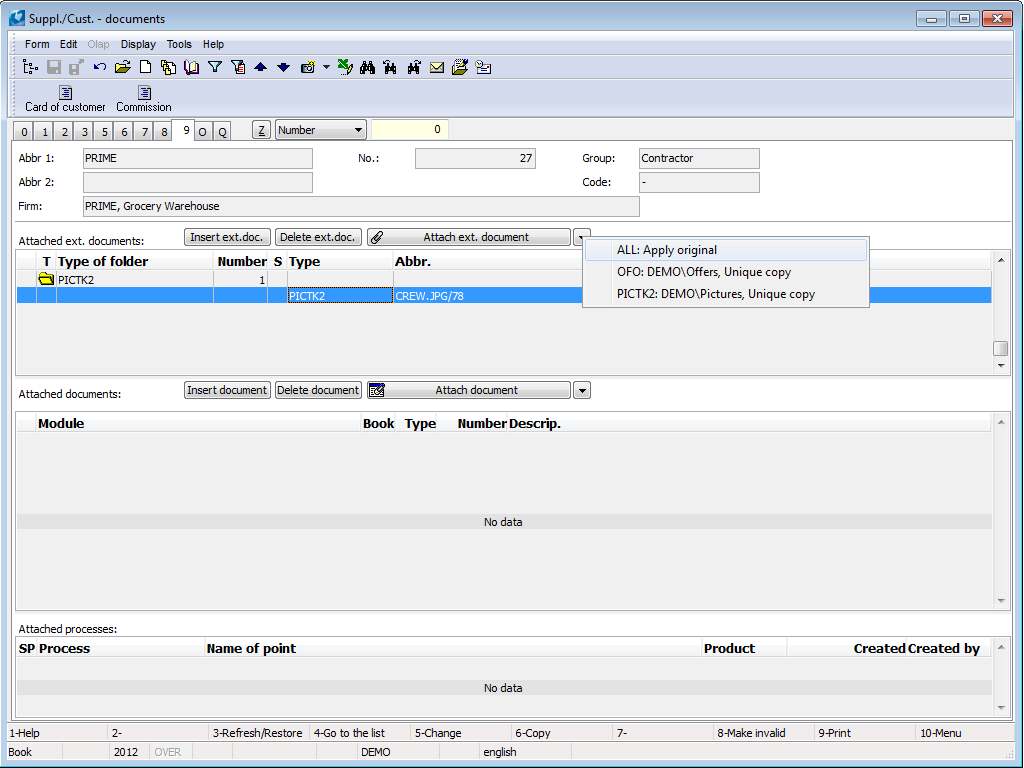
Picture: Open menu with the ext. document types
Note: If the screen resolution is low, the Attached Documents grid may overlap. To adjust the grids to the screen, use the Adjust Grids on Page 9 function. The function is available on the menu of the Form/Actions/Advanced/Adjust Grids on Page 9 module.
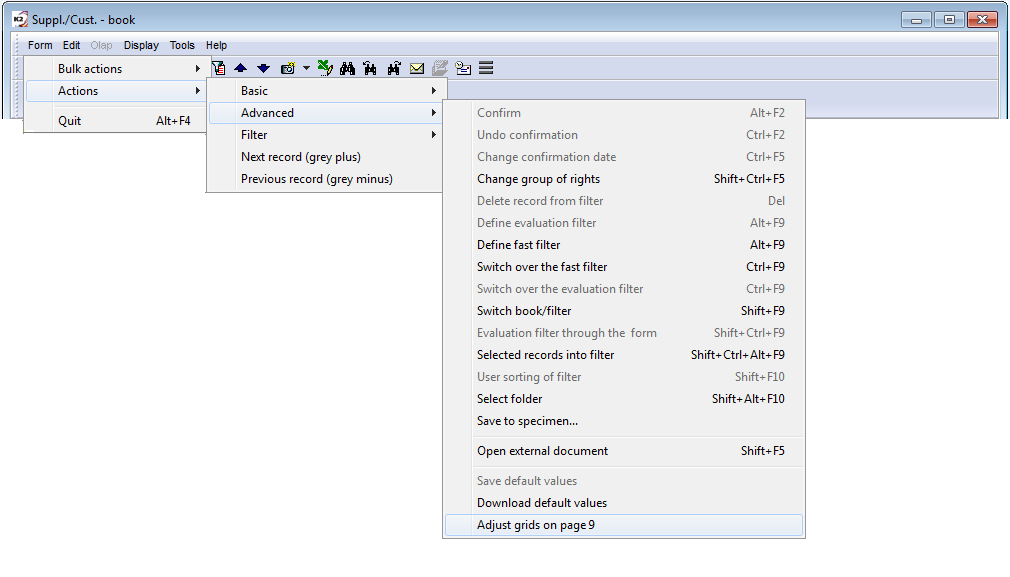
Picture: Action - Adjust Grids on Page 9
Documents
To particular documents or cards you can assign external documents in K2 IS. The external document is a file created by one of the Windows applications and saved in a concrete Windows folder. You can browse or edit the External documents assigned by this way. For editing it is used either associated application by Windows system or application set in documents parameters. It deals e. g. on contract saved in a format of text file, photographs, charts, graphic tables, drawings, etc. Proper external documents are saved in disk directories. In K2 IS only references on these external documents that are saved in a special database are stated.
Insert and delete external documents from documents
You can attach, change and detach the External documents by this way:
- In a Change mode (only in cards of unconfirmed documents) and in a New mode it is possible to attach external documents to document by Ins key or by pressing the button Insert ext. doc. You can detach external document by Delkey.
- In a Browse mode you can work with external documents in confirmed documents as well by pressing the buttons Insert ext. doc. and Delete ext. doc.
You can open the form by pressing Enter key in the External documents book.
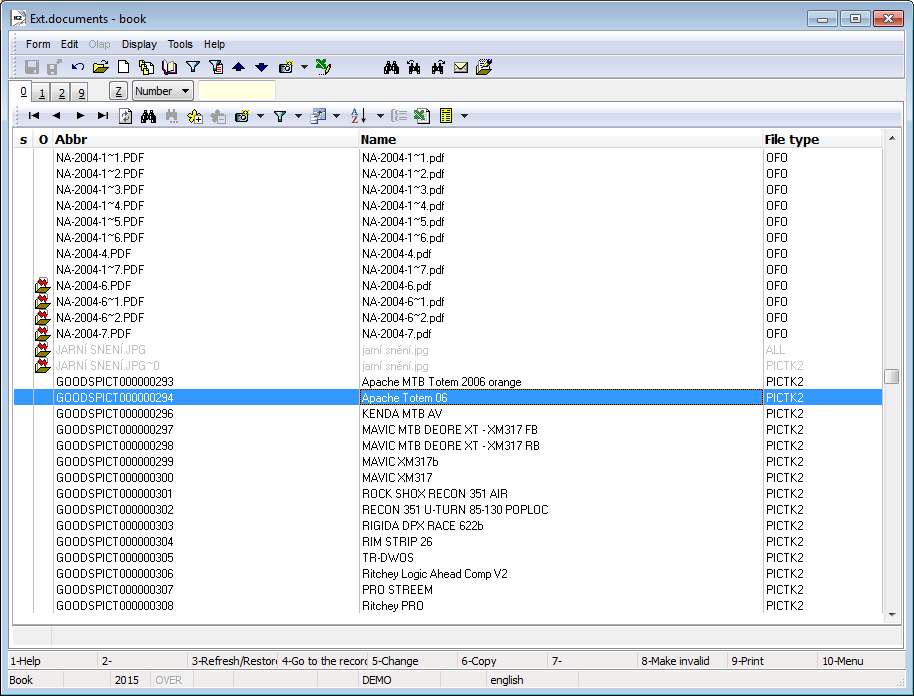
Picture: The Ext. documents book
On the 1st page of the External documents card there are the basic data, items of the work history with the document as well as attached notes.
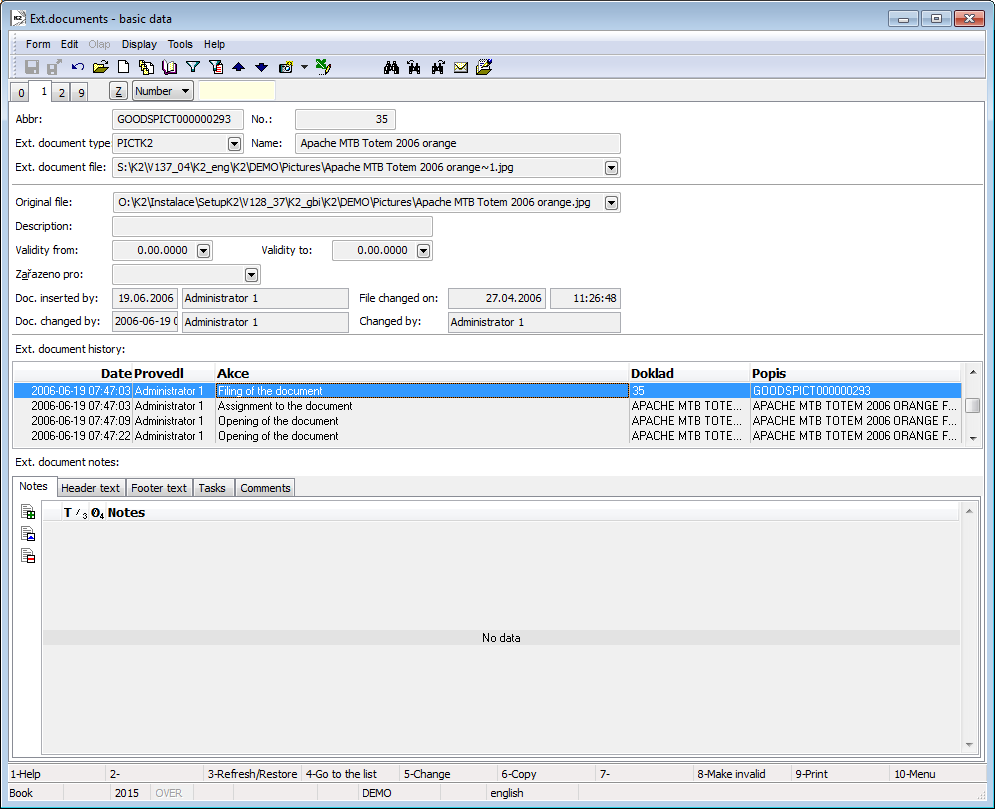
Picture: External documents - 1st page
Description of Fields:
Abbreviation |
Abbreviation of an external document is obligatory. Two external documents can not have the same abbreviation. It is used for a document identification code, according to which documents can be found. |
Number |
External document number. |
MTB |
Checking the field will allow you to open documents from a parallel database (if any). Note: After checking this field the field File of ext. doc. will be changed on the field. |
Ext. document type |
It characterizes document type and configuration of appropriate file type in K2 too (way of copying from original folder, associated application, parameters etc.). Ext document types are described below. |
Name |
This item can be filled in either with any name, or it will be automatically preset with the name of the attached file after pressing the Select button. In this case a name will be given without suffix. |
Ext. doc. file |
Name of document file including path, where a document of IS K2 will be opened. The file can be entered only in new record. If you select file by dialog window also non-existent file could be entered. If you use the button Select, this field will fill automatically according to setting in Ext. document type. |
Original file |
It contains the file name and the complete path where the file was located before the document was included in the database. The file can be entered only in a new record. If you use the Select button, this field will be filled automatically according to setting in Ext. document type. |
Valid from |
You can write the validity of this document from a certain date on the inserted document. |
Valid to |
Possibility to write validity into the date of the inserted document. |
Included for |
Select the company to which the document applies. You can select it from the Own company form (list of companies defined for the current client). You can find a description of your own companies in the Administration of own companies chapter. |
Ext. document history |
Every action, which is executed with document by K2 by user, is recorded to history of the items (attach a document, remove, open, open failure, assign to document, change a header etc.). The time of the event, who performed the action and on which document is recorded here. The items of history are not accessible in the Change mode. |
Doc. inserted by, Doc. changed by, File changed on, Changed by |
These fields are entered automatically. |
The button Select is accessible with inserting of a new document. Pressing the button opens the file selection dialog defined in the Input folder field in the Document types book. When you save a new document, the appropriate actions according to document type (copying, movement, creating of new file name, ...) will be performed and the field File and Original file won't be accessible.
On the 2nd page of the Ext. Documents card the list of the records is given. To these records the document is assigned.
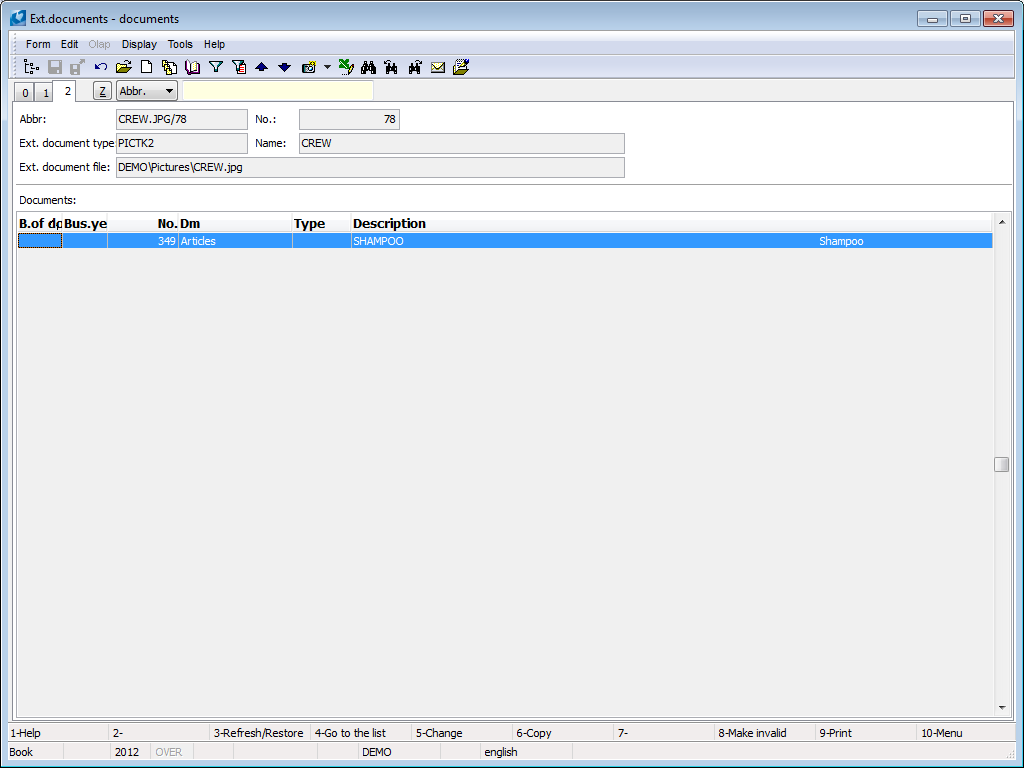
Picture: External documents - 2nd page
External document types
External document types used in K2 IS:
- OFO- creates requests in the Marketing module,
- OFI - creates requests in the Marketing module,
- PCITK2 - inserts pictures.

Picture: Ext. document type book
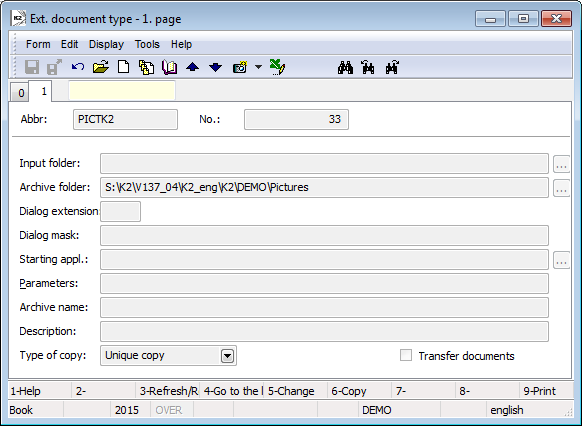
Picture: Ext. document type - 1st page
Description of Fields:
Abbreviation |
An abbreviation of an external document type. |
||
No. |
A number of an external document type. |
||
Input folder |
Presetting of a folder (directory) where a selection dialog of the files will be opened after pressing the button in an edit field or after pressing the button Selection on the 1st page of external documents. If this item is not entered, it will be done according to the last used folder (directory) after pressing the Selection button. |
||
Archive folder |
The folder (directory) where the file will be copied or moved so that they become part of the K2 arrangement files. The filling of this field is obligatory. |
||
Dialog extension |
The default suffix (extension) file dialog. |
||
Dialog mask |
The file type in a standard selecting dialog of files in Windows (after pressing the Selection button on the 1st page of an external document form). Individual sequences of characters in the text in the order of [name],[extension],[name],[extension], ... must be separated by a "vertical line". E. g. Text: Text files|*.txt|Word|*.doc|All files|*.* This example of a text fill the table by 3 types of files: by text files (files with the "txt" extension), by MS Word texts (files with the "doc" extension) and by all files. If you want to have stated more file types in one line of a standard file selection dialog, you separate them with '#'. E. g. Text: Text files |*.txt|Documents|*.doc#*.rtf |
||
|
This sample text fulfils the table with text files(files with "txt" extension) and external documents (files with „doc“ and „rtf“ extension) as well. If you select the external documents in a selection, the files with „doc“ and „rtf“ extension will display in a table immediately. |
||
Starting appl. |
You fill this field if you want to open an external document any other than the associated application. The name of a Windows starting file which requires to run the application is filled (including a path). |
||
Parameters |
Parameters are filled in that case that the field Starting appl. is filled. Here are entered sequences of characters of parameters specified after the file name of a starting application. Parameter '%S' will be supplied after the file name of an external document including path during runtime. |
||
Archive name |
If you need to replace an original file name by concrete name, this field will not be filled. |
||
Type of copy |
In a selection you can choose what will be done with an original file during assorting of an external document and how the file will get a part of K2 IS: |
||
|
Apply original |
File won't be copied or moved and only a link of original location will be written to the database. |
|
|
Overwrite by the copy |
The file will be copied to the Archive folder. If there is a file with the same name in the Archive folder, it will be overwritten with the new file. |
|
|
Overwrite by transfer |
The file will be moved to the Archive folder. If there is a file with the same name in the Archive folder, it will be overwritten with the new file. |
|
|
Unique transfer (default) |
The file will be copied to the Archive folder. If a file with the same name appears in the Archive folder, a new name will be created, differing in the number of the last characters of the name. |
|
|
Unique copy |
The file will be moved to the Archive folder. If a file with the same name appears in the Archive folder, a new name will be created, differing in the number of the last characters of the name. |
|
Open and Close the external documents
The Function Open and Close external document runs by following ways:
- By pressing the right mouse button in a bar and selection of the offered options Open external document and Close external document.
- By pressing Shift+F5 key - this key opens and closes external document (only in a Browse mode). Press Shift+F7 to open the document location.
- By Module menu Form - Actions - Advanced - Open external document/Close external document.
- By pressing Enter key.
It is possible to open and close external documents:
- on 9th page of documents or cards forms,
- on theExternal documents table or on individual pages of external document form.
In the both cases you can set the light indicator on a selected external document and run the function open (close). The difference in the procedure of open (close) will be captured in the items of external documents history in the Document column. Whereas in the first case there it can be stated e. g. Invoice out (there will be stated a book and a period) or Suppl./Cust., in the next case it will be External documents.
Open |
After pressing this button an external document will be opened by appropriate application. After that K2 IS registers the document as open. |
Open the document in the directory |
Press this button to open the document location directory. From this location, the document can be easily copied, for example, to an e-mail. |
Close |
Closing documents consists of two steps:
Note: This icon is not in a standard setting of user panel, you can select it however. |
Note: If we have one document open, it is not possible to insert a new document into the document table, nor to make changes to existing documents. As well an other document can be opened after that a previous document was closed.
Note: On the 1st page of documents forms or cards you can insert note with type Document by a standard way. Administration of these documents isn't further supported.
Icons for display state of document:
![]() Icon of Opened document
Icon of Opened document
![]() Icon of Non-existent document - this icon informs about that appropriate file is disturbed or doesn't exist
Icon of Non-existent document - this icon informs about that appropriate file is disturbed or doesn't exist
Listed icons are displayed in this places:
- on 9th page of documents or cards forms,
- on the table External documents or on individual pages of external document form.
Documents
You can insert the documents created in the IS K2 on the 9th page with the button Insert document or in the Change mode and New record by Ins key. You can select type of document from the menu.

Picture: The Document types code list
By confirming of the selection the list of the documents opens and by Enter key you insert link to a required document. You can also enter documents in bulk by selecting the documents you want to insert and confirming the selection with the Enter key. You can save it by standard F2 key.
You remove an inserted record by the button Delete document (or by Del key).

Picture: The Suppl./Cust. card - 9th page
Links
In some modules, there is an option to switch to the Links sub-tab on the Attachments tab. It is currently used mainly for webs and e-shops for attaching images and other related files to be displayed on the website / e-shop.
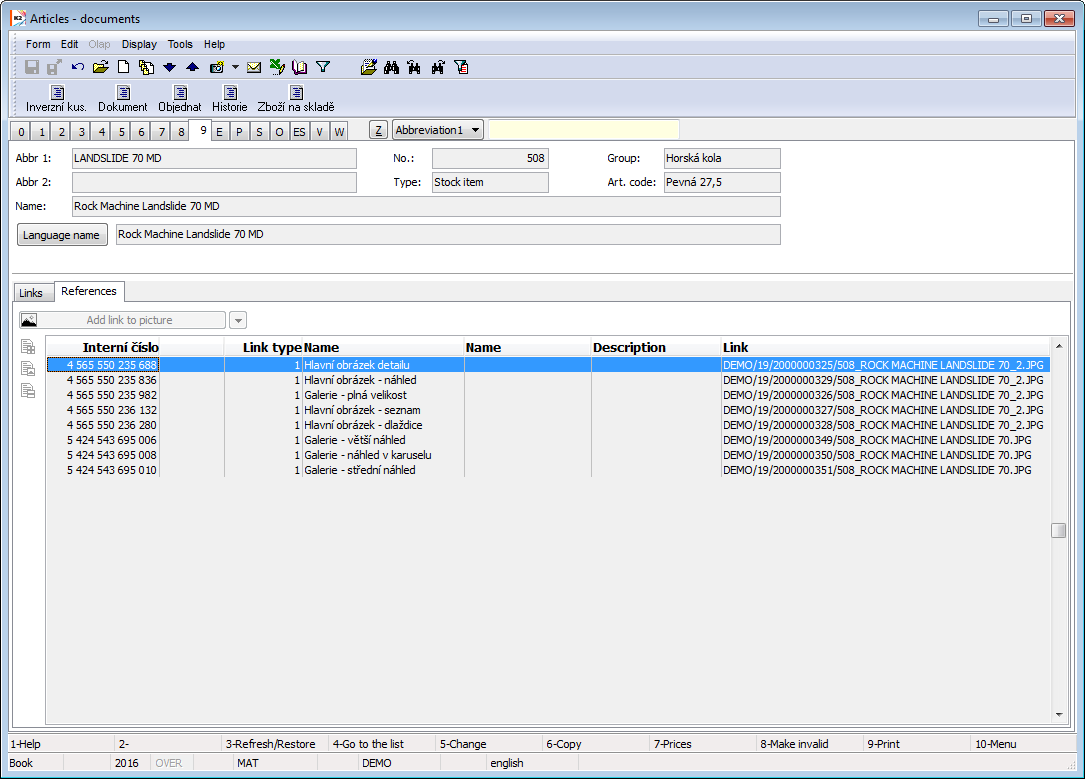
Picture: The Articles book - Attachments - the Links sub-tab
In references, you work with Categories and Types of links.
Overview and settings of Types of links
Type |
Files extensions |
Document |
doc, docx, odt, fodt, rtf, txt, xls, xlsx, ods, fods, csv, sylk, xml, pdf |
Picture |
jpg, jpeg, png, bpm, gif |
Link |
http:, https:, ftp:, sftp: |
Other |
|
Video |
mov, avi, mp4, mpg, mpe, mpeg |
Overview of categories and their default combinations with Types of links
Type |
Category - Abbreviation |
Use for e-shop |
Document |
Documents |
It is displayed on Media tab in the Documents part. |
Picture |
Main picture detail * |
For article detail, banners |
Picture |
Main picture - tile* |
For display in a tiled list of Articles |
Picture |
Main picture - view* |
For basket, history, icons of categories |
Picture |
Main picture - list* |
For display in the line list of Articles |
Picture |
Gallery - view in scroll bar |
To preview the displayed gallery in the scroll bar |
Picture |
Gallery - full size |
Full picture size from gallery |
Picture |
Gallery - medium-size view |
For overview in the gallery |
Picture |
Gallery - larger-size view |
It is not used at this moment. |
Link |
Youtube |
It is displayed on Media tab in Videos and Documents sections. |
Other |
Other |
Not used for e-shop. |
Video |
Videos |
It is displayed on Media tab in Videos section. |
* For the purposes of e-shop, there may be exactly one picture of this category on the Articles or other records tab; Graphically represents the record. |
||
New particular reference can be inserted by the buttons, which are displayed under tab label, by dragging the file to the table or by using Ins key. Then you can set or edit Name and Description of a reference.
Adding new reference by using the button
You can use either the Attach Document button to insert a new link ![]() or New Item (Ins)
or New Item (Ins) ![]() . The Attach Document button allows you to insert a new link from the default combinations of link type and category (see above). The file selection dialog box appears. Depending on the type of link, a filter corresponding to the file extensions of that type is displayed. You can switch the filter off, when you choose All files (*.*) next to the field for a file name. Then you can choose file of random type. By using the Open button, the selected file will be copied on the place, which is set by the Configuration of saving of picture references function, and new record with this reference will be created in the table.
. The Attach Document button allows you to insert a new link from the default combinations of link type and category (see above). The file selection dialog box appears. Depending on the type of link, a filter corresponding to the file extensions of that type is displayed. You can switch the filter off, when you choose All files (*.*) next to the field for a file name. Then you can choose file of random type. By using the Open button, the selected file will be copied on the place, which is set by the Configuration of saving of picture references function, and new record with this reference will be created in the table.
Insert a new link by dragging the file
If you "drag" the file, which is displayed in a folder, into a reference table in the Change mode, an offer of categories according to predefined types will be displayed (e.g. "Document: Documents" will be displayed by dragging .pdf file). By clicking on the required option, a new Link to the selected file will be created. Also in this case, the resource file will be copied onto the place, which is set by the Configure picture link storage function, and a reference is heading here then.
Insert a new link by Ins key
This way is not recommended, because the resource file is not copied - a reference will be created to the path specified by us.
If you press Ins key, the form for adding a new link is displayed. By entering the Type of references, a selection of Categories will be reduced (K2 does not allows us enter other Type of references, than it is set in Category). Then insert the file path.
Note: Standard e-shop or other K2 functionalities usually work with predefined combinations. If we create another combination, or if we do not follow the set combination, it is necessary to verify whether it is actually displayed in the desired way in the e-shop.
"Bulk" insert pictures using the script Add image to item
If you want to create a series of pictures for publication on the web / e-shop, the easiest way is to use a script: for new (template e-shop) New e-shop - Adding pictures to Articles (NewEshop_AddPicture.PAS), for old (responsive e-shop) shop) Eshop - Add pictures to Articles (Eshop_AddPicture.PAS), the use of which is described in detail in the catalogue of scripts.